What is a cleft palate?
“Palate” is another name for the roof of your mouth. The palate is both the roof of your mouth and the floor of your nose. The palate has two parts: the front, or hard palate, and the back, or soft palate. The hard palate is made of bone and the soft palate is made of muscle.
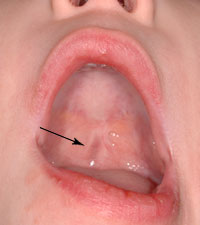 Fig. 1 – Submucous cleft palate
Fig. 1 – Submucous cleft palate
A cleft is simply a gap, separation, or hole that results from abnormal fetal development. A cleft palate is a birth defect that results when tissues of the palate fail to fuse during early fetal development. This failure occurs during the 8th and 12th week of gestation. The condition varies from a defect in the muscles of the soft palate only (a submucous cleft palate, Fig. 1) to a complete separation of the skin and bone of both the hard and soft palate (Fig. 2). It is also possible to have a cleft of the soft palate, without a cleft of the hard palate (Fig. 3). But it is not possible to have a cleft of the hard palate without a cleft of the soft palate. Cleft palate surgery is required to repair a cleft palate.
How common are cleft palates?
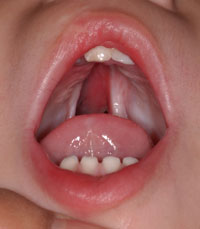 Fig. 2 – Cleft of hard and soft palate
Fig. 2 – Cleft of hard and soft palate
Roughly 1 out of every 900 children are born with a cleft palate. About 70% of these children will also have a cleft lip. The other one third will have only a cleft palate. Most cleft palates involve both the hard and soft palate.
What causes a cleft palate?
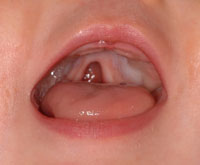 Fig. 3 – Cleft of soft palate
Fig. 3 – Cleft of soft palate
It may surprise you to know that despite years of research we still do not have a great understanding of why cleft palates occur. Most doctors and scientists agree that clefts are a combination of genetic as well as environmental factors including drugs, infections, maternal illness, and possibly vitamin deficiencies.
Other birth defects can occur in children with cleft palates. Some of these defects are obvious and some are more difficult to detect. However, most children born with a cleft lip and/or palate are otherwise normal, healthy children.
How do I feed my child with a cleft palate?
It is extremely difficult to successfully breast feed a child with a cleft palate. This is one of the many reasons that children in developing countries born with cleft palates do not survive past infancy.
In order for a child to breast feed (or bottle feed with a conventional nipple), he/she needs to create suction within the mouth. Suction cannot be created when there is an opening, or cleft, in the roof of the mouth.
Some well-intentioned friends and/or medical professionals may encourage you to try and breast feed your child anyway. Unfortunately encouraging a mother to breast feed a child with a cleft palate only sets mother and baby up for failure. But rest assured, there are ways to successfully feed a child with a cleft palate.
Special nipples are available that allow you to help deliver formula or pumped breast milk from a bottle into your infants mouth. Feeding a baby with a cleft palate takes time and patience. Many resources are available to help you and your family learn the techniques to successfully feed your child. More specific information is available on our cleft lip and palate feeding page. If you are having difficulty successfully feeding your child, please call our office to arrange some assistance.
Why is a cleft palate repaired?
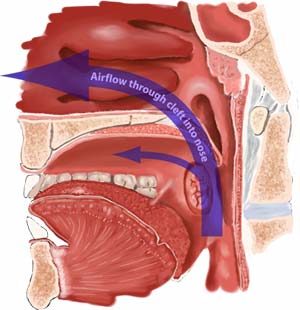 Fig. 4 Nasal air escape
Fig. 4 Nasal air escape
If a child can eat and drink with a cleft palate, you may wonder why a cleft palate needs to be repaired at all. The reason is simple—speech.
Most human speech and language requires regulation of air flow through the nose and mouth. If air leaks out of the nose while we are speaking, many of the sounds we make do not sound right. When a lot of air leaks out of the nose, our speech becomes almost unintelligible.
A child with an unrepaired cleft palate cannot stop air from rushing out the nose during speech (Fig. 4). This makes it very difficult for a child to learn how to speak correctly. It also makes it difficult for others to understand his/her speech.
How is a cleft palate repaired?
The repair of a cleft palate requires cleft palate reconstructive surgery and general anesthesia. The cleft is repaired by bringing the tissues around the cleft together. There is no need for artificial materials or bone grafts in order to repair the palate (Fig. 5).
(However, it is important to remember that some children with cleft lip and palate have a cleft in the gum line in addition to a cleft in the hard palate. Although the cleft of the hard palate is repaired early in life, the cleft in the gum line is not repaired until your child is much older—usually between 6 and 8 years old. Repair of the gum line does involve a bone graft.)
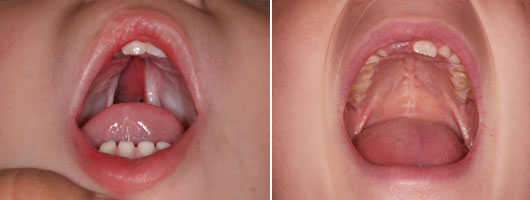 Fig. 5 – Cleft palate before and after repair.
Fig. 5 – Cleft palate before and after repair.
When is the right time for cleft palate surgery?
Cleft palates are typically repaired between 8 and 12 months of age. Clefts of the soft palate can usually be repaired early (8 to 10 months of age). Clefts of the hard and soft palate are best repaired later (10 to 12 months of age). Research tells us that the earlier the cleft is repaired the better the speech results will be.
It is also important that your child has transitioned away from bottle feeding to eating table foods and drinking from a “sippy“ cup before palate surgery. Using a bottle and nipple immediately after cleft palate surgery may damage the newly repaired palate.
Submucous clefts are not repaired early in life. A submucous cleft only needs to be repaired if speech and language are affected. Approximately 50% of children with a submucous cleft palate will require surgery to repair it. The other half will not need any surgery. It is usually possible to determine the need for submucous cleft palate repair between 3 and 6 years of age.
Are there any instructions I need to follow before cleft palate surgery?
Your child must have a physical examination by his or her pediatrician or family doctor within 7 days before surgery to make sure he or she is in good health. The doctor you see needs to complete the History and Physical form provided by our office. You must bring the completed form with you the day of surgery.
Your child should be drinking from a “sippy” cup and eating table foods before cleft palate surgery. Most children begin this transition 1 month before surgery. If you are having trouble weaning your child off the bottle, please let your surgeon know at least 4 weeks before your planned date for surgery. Your surgeon will delay cleft palate surgery if your child still requires any bottle feeding.
For your child’s safety, it is very important that he or she have an empty stomach when anesthesia is given. Please follow our preoperative Eating and Drinking Guidelines. If you do not follow these guidelines, your child’s surgery will be cancelled.
What can I expect after surgery?
A cleft palate repair surgery usually takes between 2 and 3 hours. Your doctor will talk to you as soon as the surgery is over.
Your child will wake up in the recovery room after surgery. This may take 45 minutes to an hour. When your child is awake, he or she will be admitted to the hospital. You can accompany your child when he/she is transferred to your hospital room. One or both parents can stay with your child the entire time he/she is in the hospital. In fact, we encourage at least one parent to stay with your child during the hospitalization.
After surgery, your child will have soft splints wrapped around the arms. These splints prevent your child from inserting hands and objects into the mouth. These splints can easily be removed when you are holding your child. The arm splints should be worn at all other times for 2 weeks after surgery.
Children usually start drinking 24 to 36 hours after surgery. Your child will receive fluids through an intravenous catheter until he/she starts drinking by mouth. Children are usually discharged from the hospital after 2 nights. In some cases a child may have trouble feeding or need a little more time in the hospital to control pain.
How should I take care of my child after surgery?
There is no special wound care required following a cleft palate surgery procedure. If you look at the roof of your child’s mouth during the first 2 weeks after surgery you may see white areas on the inside borders of the teeth. These white areas are scabs that form inside the mouth. There is no cause for alarm—these white plaques do not represent infection and will slowly disappear as your child’s mouth heals.
In addition to drinking from a “sippy“ cup, it is okay to feed your child solid foods. It is important that these foods be soft, without any large chunks or granules which may get stuck in the healing gaps between the palate and the teeth. Vegetable purees, noodles, applesauce, and the like are ideal. After 2 weeks from surgery your child can resume eating any foods in his/her normal diet.
If your child seems to have discomfort you can safely give Tylenol® (acetaminophen), Children’s Motrin® (ibuprofen), or other pain medicine prescribed by your doctor. If you are not sure what medicines are safe, please call your doctor.
Your doctor will usually prescribe a short course of antibiotics for your child after surgery.
What else do I need to know?
A postoperative visit is usually scheduled 3 to 4 weeks after surgery. Your doctor will check the palate to see how it is healing, and ensure that cleft palate surgery recovery is on track.
Dissolving stitches are used to repair the palate. These stitches will slowly dissolve over 4 to 6 weeks. It is not unusual to see these stitches along the center of the palate even a month after surgery.
In rare cases an opening will appear in the palate after surgery. This is called a fistula [FIS-chew-lah] and results from poor wound healing. If your child develops a fistula it may need to be repaired. Some small fistulas can be left alone until your child is older. Large fistulas may be repaired earlier. Your surgeon will wait at least 12 months after the initial palate repair before repairing any fistulas.